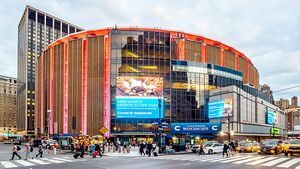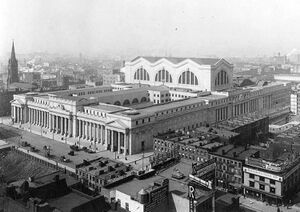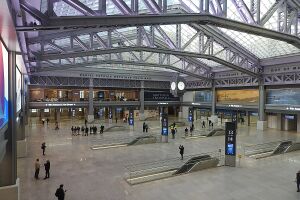Pennsylvania
| Pennsylvania | |||||
|---|---|---|---|---|---|
| Japanese Name | ペンシルベニア | ||||
| Weapon | |||||
| Race | Elf | ||||
| Nationality | |||||
| Birthday | December 12 | ||||
| Constellation | Sagittarius | ||||
| Talents | Archery | ||||
| Likes | Roasted wild animals whole | ||||
| Dislikes | Expensive food, Branded apparel | ||||
| Strengths | Does not speak ill of others and always looks for their good qualities | ||||
| Weaknesses | Inconsiderate once the topic involves archery | ||||
| Hobbies | Hunting | ||||
I'm from the Order of St. Iris, call me Pennsylvania. Um, I was a Verforench. I used to be part of Verforet Gendarmerie, too. A whole lot happened and I ended up moving to St. Iris in the end. My goal and dream is to become the world's best archer. It's a pleasure to meet you.
Layers
| Icon | Title | Release Date | Where to Obtain |
|---|---|---|---|
| [Student From the Forest] Pennsylvania | 2021 November 22 (EN) | [Altar of Judgement - Gale Griffon] Event Reward | |
| [Devoted to the Bow] Pennsylvania | 2022 May 16 (EN) | [Ant Hell in the Shahara Desert] Pick Up Gacha | |
| [Aiming for Secluded Hot Springs] Pennsylvania | 2022 December 23 | [Détective Controversée & the Shy Veterinarian] Limited Gacha | |
| [Unrelenting Bow] Pennsylvania | 2021 November 22 (EN) | [Genius Girl Bow] Limited Gacha | |
| [Under Tree-Flittered Sunlight] Pennsylvania | 2021 September 16 | 1st Anniversary Limited Gacha 1 |
Owned Skills
Trivia
- Pennsylvania' birthday is the date where Pennsylvania became the second state to ratify the United States Constitution in 1787.
- The building in the background of [Unrelenting Bow] is Madison Square Garden in New York City. Pennsylvania Station is directly below Madison Square Garden.
- Pennsylvania Station (commonly referred to as "New York Penn" or "Penn Station") derives its name from its original owner, the Pennsylvania Railroad Company, a company headquartered in the state of Pennsylvania but which operated stations in several states including the one in Manhattan, New York City.
- The hiking theme of [Aiming for Secluded Hot Springs] may refer to the large number of mountain range hiking trails throughout Pennsylvania and upstate New York, such as the Alleghenies, the Adirondacks, and part of the Appalachians.
- The Amtrak logo can be seen engraved on the weapon of Pennsylvania's bow in [Unrelenting Bow]. Her muffler also has the Broadway Limited logo.
- The etymology of Pennsylvania is a combination of the Englishman William Penn, who was the governor of the Province of Pennsylvania, and Sylvania, which means forest. In other words, this makes Pennsylvania an elf.
- Pennsylvania is likely designed as elf due to its former history of the French Azilum, where it was a planned settlement built in 1793 in Bradford County, Pennsylvania for French refugees fleeing the French Revolution and slave uprisings in Saint-Domingue. Several influential Philadelphians, including Stephen Girard, Robert Morris and John Nicholson, Pennsylvania's comptroller general, were sympathetic to the exiles, and also saw a chance to profit financially.
- Alternatively, her design may derive from the Beaux-Arts styling of the original 1910-1963 New York Pennsylvania Station. Beaux-Arts is an elaborate French architectural style named after the Beaux-Arts de Paris academy, incorporated into many of New York City's famous buildings such as the Metropolitan Museum of Art and Grand Central Station.
Counterpart
Pennsylvania Station, also known as New York Penn Station or simply Penn Station, is the main intercity railroad station in New York City and the busiest transportation facility in the Western Hemisphere, serving more than 600,000 passengers per weekday as of 2019. It is located in Midtown Manhattan, beneath Madison Square Garden in the block bounded by Seventh and Eighth Avenues and 31st and 33rd Streets, and in the James A. Farley Building, with additional exits to nearby streets. It is close to Herald Square, the Empire State Building, Koreatown, and Macy's Herald Square.
Penn Station is named for the Pennsylvania Railroad (PRR), its builder and original owner, and shares its name with several stations in other cities. The current facility is the remodeled underground remnant of the original Pennsylvania Station, a more ornate station building designed by McKim, Mead, and White and considered a masterpiece of the Beaux-Arts style. Completed in 1910, it enabled direct rail access to New York City from the south for the first time. Its head house was torn down in 1963, galvanizing the modern historic preservation movement. The rest of the station was rebuilt in the following six years, while retaining most of the rail infrastructure from the original station.
During half a century of operation by the Pennsylvania Railroad (1910–1963), scores of intercity passenger trains arrived and departed daily to Chicago and St. Louis on "Pennsy" rails and beyond on connecting railroads to Miami and the west. Along with Long Island Rail Road trains, Penn Station saw trains of the New Haven and the Lehigh Valley railroads. A side effect of the tunneling project was to open the city up to the suburbs, and within 10 years of opening, two-thirds of the daily passengers coming through Penn Station were commuters.
The original station put the Pennsylvania Railroad at comparative advantage to its competitors offering direct service from Manhattan to the west and south. Other railroads began their routes at terminals in Weehawken, Hoboken, Pavonia and Communipaw which required passengers from New York City to take the interstate Hudson Tubes (now PATH) or ferries across the Hudson River before boarding their trains. By 1945, at its peak, more than 100 million passengers a year traveled through Penn Station.
By the late 1950s, intercity rail passenger volumes had declined dramatically with the coming of the Jet Age and the Interstate Highway System. The station's exterior had become somewhat grimy, and due to its vast scale, the station was expensive to maintain. A renovation covered some of the grand columns with plastic and blocked off the spacious central hallway with a new ticket office. The Pennsylvania Railroad optioned the air rights, which called for the demolition of the head house and train shed, to be replaced by an office complex and a new sports complex, while the tracks of the station would remain untouched.
A giant steel deck was placed over the tracks and platforms to allow rail service to continue during construction. Photographs of the day showed passengers waiting for trains even as the head house was demolished around them. This was possible because most of the rail infrastructure (including the waiting room, concourses, and boarding platforms) was below street level.
Plans for the new Penn Plaza and Madison Square Garden were announced in 1962. In exchange for the air rights to Penn Station, the PRR would receive a smaller underground station at no cost and a 25 percent stake in the new Madison Square Garden Complex. Modern architects rushed to save the ornate building, but to no avail; demolition of the above-ground head house began in October 1963.
Post-1968, the core Penn Station has been underground, sitting below Madison Square Garden, 33rd Street, and Two Penn Plaza. The core has three levels: concourses on the upper two levels and train platforms on the lowest. The underground Penn Station continued to be criticized as "reviled," "dysfunctional," and a low-ceilinged "catacomb" lacking charm, especially when compared to the much larger and more ornate Grand Central Terminal. The New York Times, in a November 2007 editorial supporting development of an enlarged terminal, said that "Amtrak's beleaguered customers...scurry through underground rooms bereft of light or character," and Times transit reporter Michael M. Grynbaum called Penn Station "the ugly stepchild of the city’s two great rail terminals." After its nadir in the 1960s, ridership exploded in subsequent decades, a situation never contemplated by the structure's designers. By the 2010s, the station operated at almost three times its intended capacity; 450,000 intercity and commuter riders and 330,000 subway riders used the station daily in 2019. Wikipedia
Map
Gallery
- Pages using Tabber parser tag
- Pages using DynamicPageList3 parser tag
- Weapon Bow
- Elf
- St. Iris
- Sagittarius
- Element Pierce
- Element Wind
- Train Knights
- United States

















